• GPX file (1 of 3)
• GPX file (2 of 3)
• GPX file (3 of 3)
• Profile (1 of 3)
• Profile (2 of 3)
• Profile (3 of 3)
• Logbook
• Where are we?
Photo album:
• Tongariro NP and Coromandel
Recommended services:
Did you find our website useful?
THANK YOU!
Leg breakdown:
Date Activity Leg Distance (Km) Elev. Gain (m) Elev. Desc. (m) 26-Apr-19 Riding Wellington to Upper Hutt 37.7 99 50 27-Apr-19 Riding Upper Hutt to Martinborough 63.2 425 473 28-Apr-19 Riding Martinborough to Masterton 45.1 168 74 30-Apr-19 Riding Masterton to Eketahuna 47.9 349 225 1-May-19 Riding Eketahuna to Ashhurst 62.4 434 595 2-May-19 Riding Ashhurst to Apiti 59.3 875 471 3-May-19 Riding Apiti to Mangaweka to Waiouru 41.2 484 607 4-May-19 Riding Waiouru to National Park Village 63.6 464 444 5-May-19 Hiking Tongariro Alpine crossing 21.7 464 959 6-May-19 Riding National Park to Turangi to Tauranga 50.8 372 822 7-May-19 Riding Tauranga to Waihi beach 58.2 385 384 8-May-19 Riding Waihi beach to Whangamata 39.4 439 440 9-May-19 Riding Whangamata to Hot water beach 61.8 585 600 10-May-19 Riding Hot water beach to Cathedral cove and back 19.9 325 325 11-May-19 Riding Hot water to Coromandel town to Auckland 63.3 548 553 Total 735.5 6763 7022
23 April - 14 May, 2019: Wellington, Manatawu, Tongariro NP and Coromandel
Leaving big cities by bike is always complicated and Wellington is no exception. According to our map, it should be easy and without risks, since it shows a dedicated bike lane parallel to the highway. The strange thing is that we are riding on the opposite side of what we expected. On the left we have the cars coming in the opposite direction and on the right the train tracks. The noise is annoying but we are thankful for not having to pedal on the shoulder of the highway. After a couple of kilometers, we see a cyclist approaching riding on the shoulder in the opposite direction to ours. He is crazy! We would never pedal on the shoulder of a highway! We can’t find an explanation for not using the bike lane and we move on. After a few minutes, another crazy rider goes towards Wellington on the highway shoulder. After 1 km, suddenly, our bike lane ends at the shoulder of the crazy riders. We do not understand what's going on, but we are not pedaling on the highway shoulder with cars and possibly other crazy cyclists coming. We turn around and ride back to the starting point of the bike path. While we ride back, we see that there are also bikes on their way out of Wellington on the shoulder of the exit lanes. In a few minutes there will be two more crazy riders (us!). The experience is not pleasant at all. While the cars and trucks pass at full speed, we pedal as fast as we can on a shoulder with bicycles painted on the asphalt every few hundred meters. One wonders if they are to indicate that this shoulder is a bike path or in memory of run over cyclists (similar to the silhouettes of kiwis - the bird - that we have seen painted on several of the country's roads). Luckily, it’s only a few kilometers to the first exit, where we get off the highway.
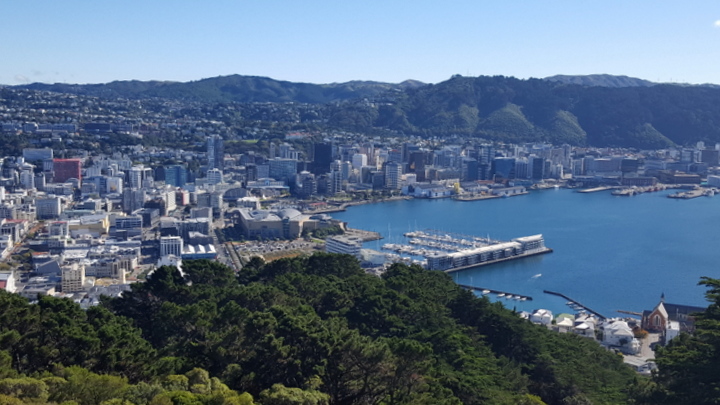
The objective of this first day of travel between Wellington and Tongariro National Park was too aggressive. We wanted to cross the Remutaka mountain range to sleep in the Martinborough vineyards. The wasted time and the stress of the highway make us reconsider today’s route and stay in a campsite in Upper Hutt. When we arrive to the town we stop for a coffee, before heading to the campsite. In the coffee shop we share a table with a couple of locals. We start chatting and they end up inviting us for dinner and sleep at their home. Another example of kiwi hospitality.
The bike path that crosses the Remutaka mountain chain is an old railway. The slopes are gentle and the terrain is firm, so despite the uphill, we make good progress. The Remutaka cycleway includes several tunnels in which you have to use a headlight, as they are not illuminated.
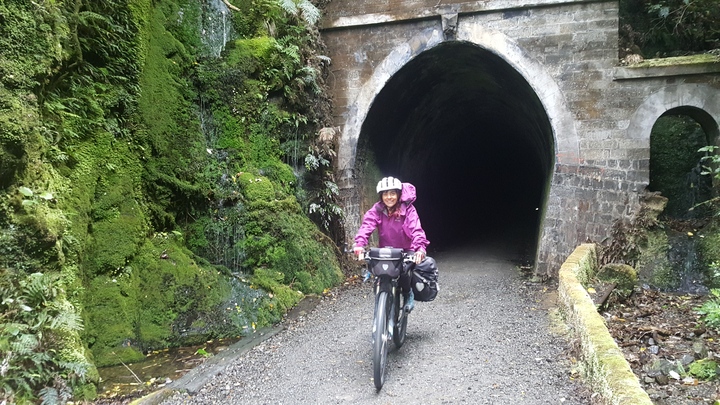
Apart from the vineyards and the numerous wine tasting options, the towns of this area are also famous for their Victorian houses and streets with very well preserved buildings of that time.
Our route continues to the North and we enter the Wanganui-Manawatu region. Now we are following the Manawatu cycleway that goes through very secondary roads between sheep and cow farms. The villages that we pass are very small and separated by tens of kilometers. In Eketahuna we stay in the town’s "hotel". We are lucky. Tonight there is a dinner offer: 2 for 1 steak with fries. For 10 NZ $ per person they bring us an overflowing plate in which the steak is straddling the fries and the salad. While we are having dinner it starts to rain again. We notice a leak less than a meter away from the table. Let's hope there are no leaks in our room... A worn out and faded carpet covers practically the entire room, probably to hide an even older carpet in worse shape. The window, which faces the street, does not fit well and the icy wind that enters makes a curtain stiff like cardboard swing. But we have an electrical heater and lots of blankets that weigh a tone. In addition, the mattress has heating elements. We could plug it in and it would warm us. Just in case, seeing the premises maintenance conditions and with the falling rain, we chose to not use it, to reduce the risk of waking up electrocuted.
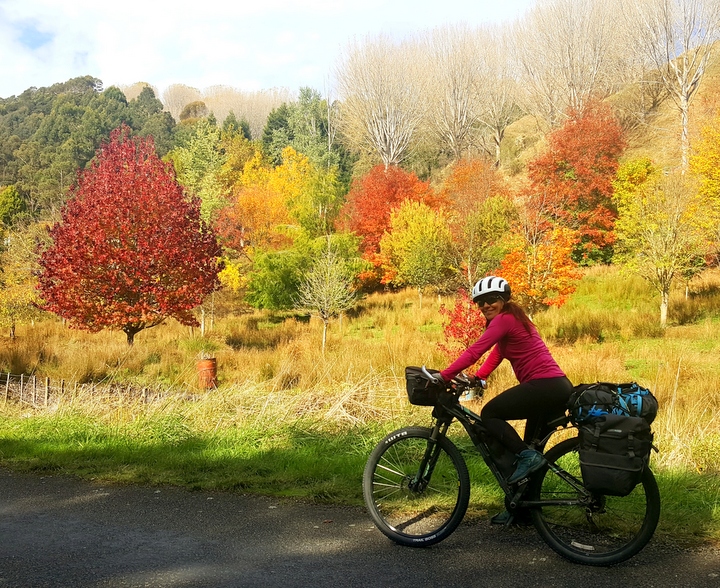
In Apiti we camp on the side yard of the village’s tavern. Of course, we have dinner in the tavern where we order a hamburger with everything, even fried egg. The owner is worried about the cold forecast for tonight and asks us if we want to take some blankets to the tent. The next morning we don’t get out of the sleeping bag until the sun hits a section of the yard where we go to prepare breakfast. We look like lizards warming up after a cold night. Until now we have ignored the fall. But the cold nights, the short days and above all the colors of the trees force us to admit that we are closer to winter than to summer. At 9 o'clock the owners of the tavern show up and we chat with them for a long time.
Finally we start riding. The route continues up and down to cross the gorges of the rivers on our way. When we reach the highest point of the cycleway, we are surprised by the view. The Ruapehu volcano, the highest peak on the island, dominates the horizon. Its southern face is snowed halfway up, one more clue that winter is approaching. It also indicates how close we are to Tongariro National Park, our next goal.
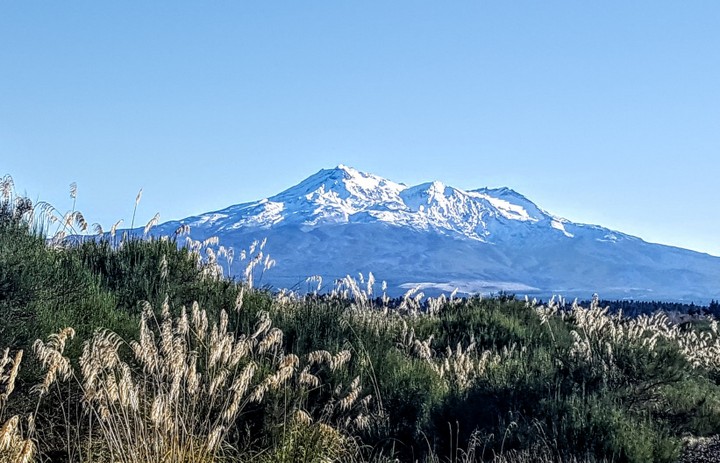
The end of the Manawatu cycleway is in the Mangaweka locality, on Highway 1. Here there is no escape through secondary roads. We have read that the shoulder in this section of the highway is very narrow or even non-existent in some stretches, so instead of pedaling we get on a bus to Waiouru. Waiouru is a settlement to serve the important military camp nearby but has a motel that is perfect for the night. There we finally eat the vegetables cooked with spices that we have been carrying from Wellington, for the last 4 days. The temperature during the last week has not exceeded 60F degrees, so we could say that we have kept them in the refrigerator.
From Waiouru, the volcanoes are the stars of the rest of this chapter. It's going to take us a couple of days to circle the Tongariro National Park to the west. During the first hours of the first day, despite being sunny, we have to wear the long gloves and the Gore-tex jackets because of the cold. It is one of those days where you pedal with your neck pulled back so you can sink your nose, which doesn´t stop running, in the neck of the jacket. One of those days when you hate descents, because the fingers become numb, your eyes are covered with tears and chills run down your spine. The worst are the shady areas, now more frequent because the sun is much lower. Our day ends in National Park Village, where a long hot water shower makes us forget the shivers of the day.
National Park is the closest village to the Tongario alpine crossing trailhead. This is the park's most popular hike. The recommended season is already over. The weather here is very unpredictable and even in summer it can snow at the highest point of the route (1860 m), so we have been monitoring the weather forecast for several days. Despite the warnings about hypothermia and possible severe weather in the hostel and along the route, there are always people who leave their brains in their home country and set off to complete the 19 km in shorts and T-shirt. When we reach the base of the red crater ridge, the fog still blocks the sun and with the chill factor, it's 34F according to the forecast. We are wearing 4 layers of clothes, gloves, hat and hood. The bare arms and legs of the brainless hikers are reddish due to the cold and fog but they keep going up. Maybe they flew to New Zealand with their little brain but it was confiscated in customs deemed as bio toxic waste. This is how accidents happen! In fact, this trek is the one with the highest number of rescues per year in the country. It must be said that at the peak of the high season, 5000 people walk the alpine crossing each day.
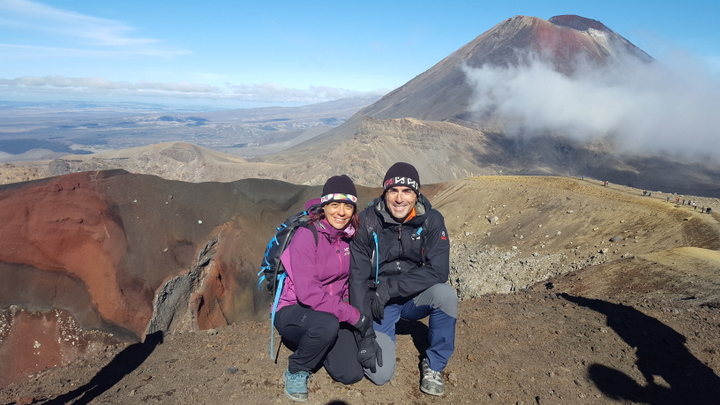
Fortunately for all, the fog clears up, the wind dies out and the temperature rises a few degrees. In particular for the idiots, because now their trembling bodies can warm up. Luckily for us too, because the views we had come to see begins to show off. We can see the perfect cone of the Ngauruhoe clear of clouds showing its beauty. From the ridge of the red crater you can see all kinds of reddish colors on the inner walls of the crater. From there you can also see the emerald lakes, where a loose volcanic gravel path goes down to. The emerald lakes have a bright green color, almost unreal. When passing by its shore we can smell the sulfhydric gases of the nearby fumaroles. On the other side of the central crater is the blue lake. The trail crosses this crater, apparently harmless, but the ancient lava flow that crosses it reminds us that this is a very active area. After a long descent, the path goes through a dense forest with giant ferns. Nothing compared to what we have seen in Fiordland, but for hikers who have not seen them, it is a surprising end after the arid and desolate terrain of the craters. In short, an absolutely spectacular and highly recommended hike and we are not surprised that it is listed as one of the best day trips in the world.
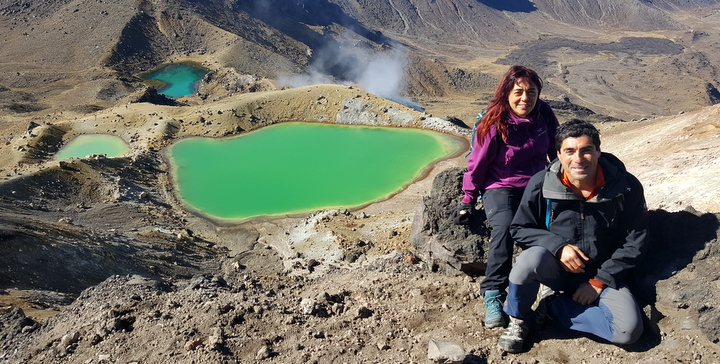
There are fewer and fewer days left before our return to San Diego. We have decided to spend the last days pedaling on the Coromandel Peninsula, east of Auckland. We don’t have time to get there by bike so we take a bus that brings us to Tauranga, in the Bay of Plenty. From there to the base of Coromandel we ride on highway 2. This stretch is very stressful, even dangerous. The shoulder is irregular and narrow and nonexistent on the bridges. The cars pass at full speed and the double-trailer trucks scare us to death. Along the road there are several fruit stands, supplied from the surrounding orchards. We stop in one of them to relax from stress. While we buy some fruit an SUV with a trailer in which the bikes would fit pulls out... We don’t think about it twice and we ask the driver if they can take us. The answer is, as we expected, yes. Too bad they don’t go far, but they save us 10 km of suffering.
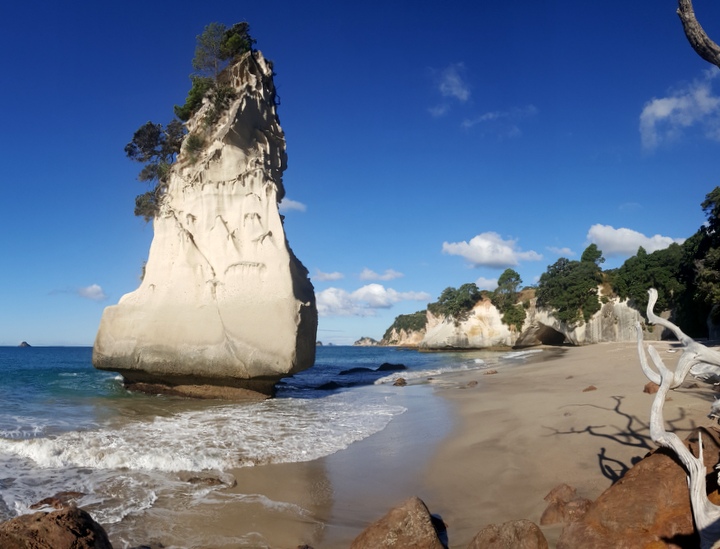
The two most impressive visits are the Cathedral Cove and the Hot Water Beach. In the first, the sea has eroded the compacted sand rock and created a huge tunnel, in addition to pointy islets.
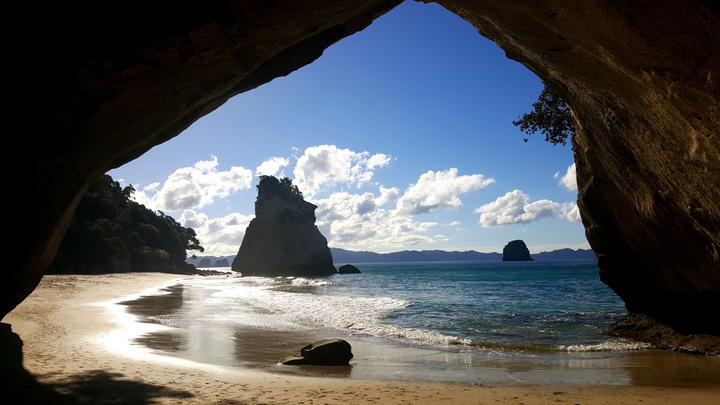
The Hot Water Beach is undoubtedly the best experience on the peninsula. At low tide you can dig your own personal spa in the sand. An underground water flow at 60 ° C oozes near the shore. You have to do a good prospecting job before choosing the place to dig. If you're too close to the hot points you'll be scalded like a chicken. If you are too far away, you will be cold. It is best to build a dam with the sand and regulate the flow of hot water that enters your spa.
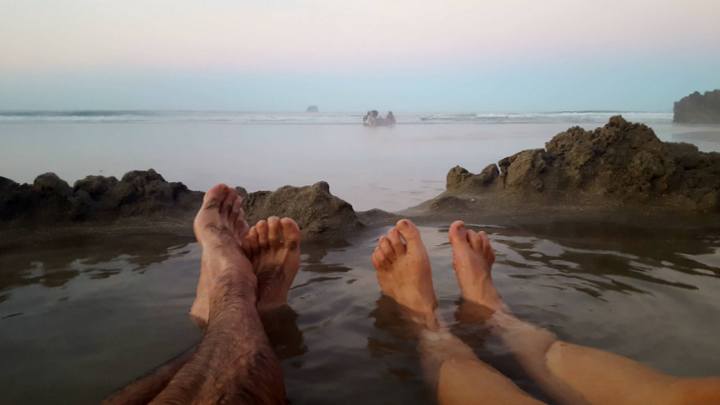
On the ferry that takes us to Auckland we savor the last sunset we will see in this wonderful trip that has taken us across the country for 6 months, enjoying such varied landscapes. From the remote coves of Northland to the fjords of Southland, passing through geothermal areas, the Southern Alps, the rainforests of the West Coast and the beaches of the Tasman region. And in all those places we have always found lovely people, not only willing to offer their help, but to show their hospitality. In few places one feels so welcome. In few places you can travel so relaxed, without distrusting those around you, without having to watch for your luggage. Traveling in New Zealand has been an unforgettable experience!
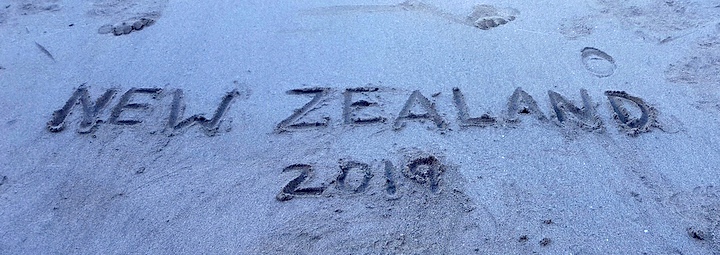
© 2018 Explore Pangea. All Rights Reserved. Website Terms of Use.